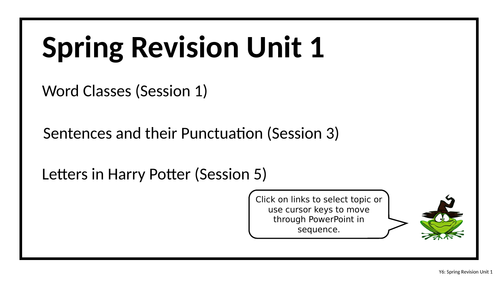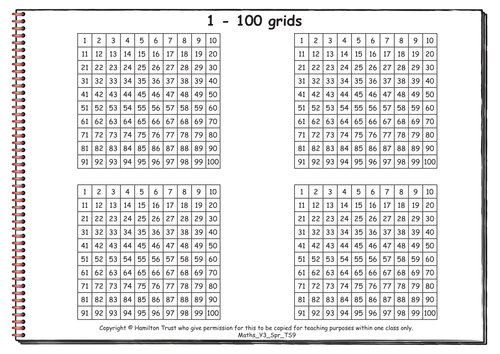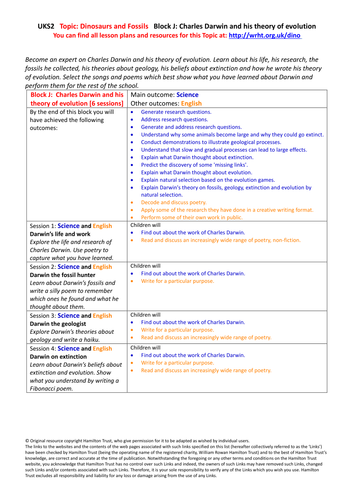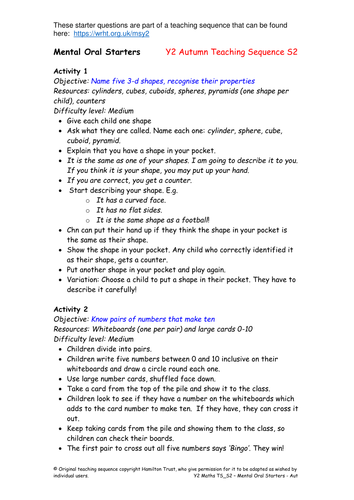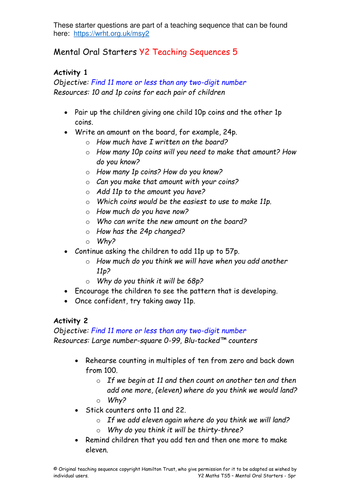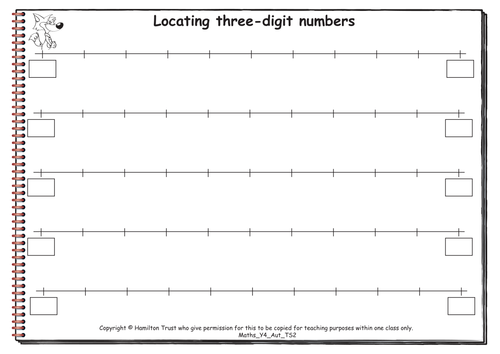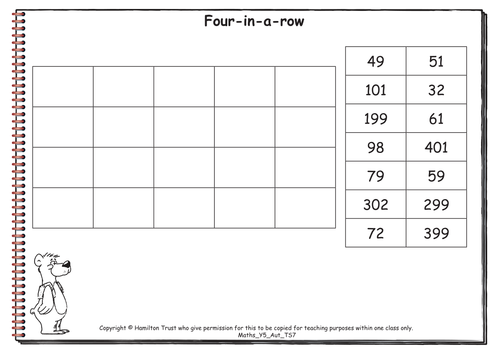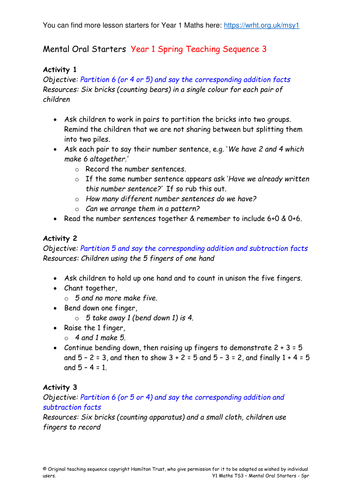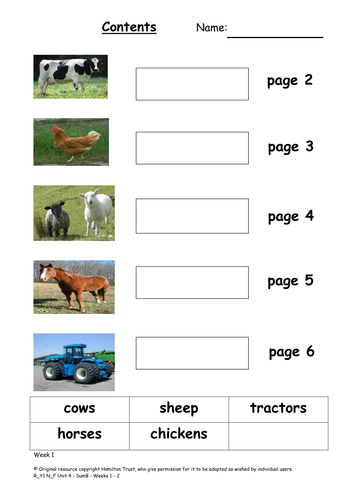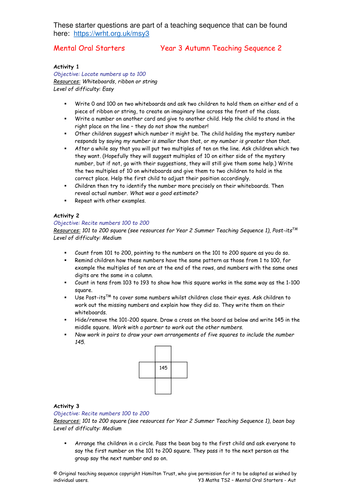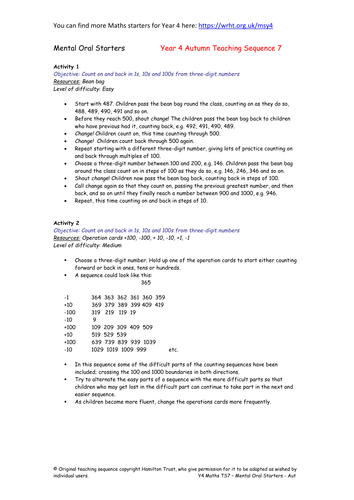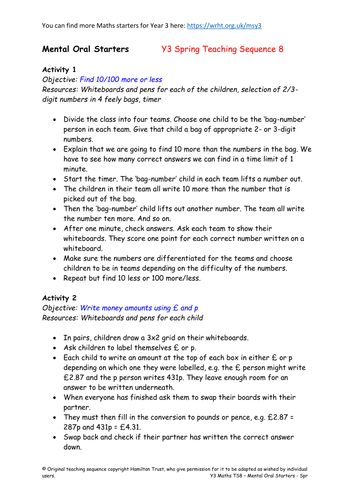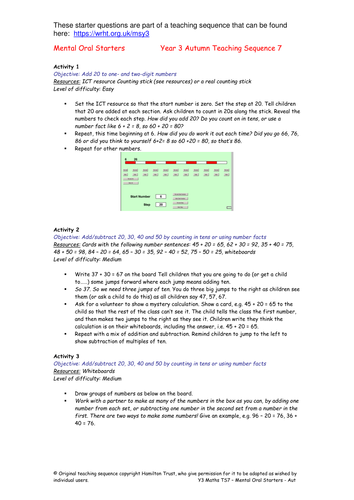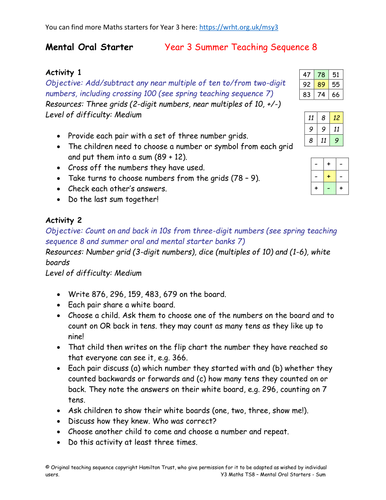
3k+Uploads
9970k+Views
11585k+Downloads

Maths Y3 Spring Teaching Sequence 9
Reasoning and explaining (three days).
Children arrange numbers 1 to 6 to solve a puzzle, using known facts to help. They investigate a number of solutions. Properties of numbers are used to describe a number, and then given as clues for children to guess mystery numbers. They also make up their own clues. Children solve ‘I’m thinking of a number…’ problems involving one, then two simple functions, and then make up their own similar puzzles.
Find additional lesson plans and resources at www.hamilton-trust.org.uk.

Dinosaurs and Fossils - Charles Darwin and his theory of evolution - Upper Key Stage 2
Be a palaeontologist! Become an expert on Charles Darwin and his theory of evolution. Learn about his life, his research, the fossils he collected, his theories about geology, his beliefs about extinction and how he wrote his theory of evolution. Select the songs and poems which best show what you have learned about Darwin and perform them for the rest of the school.
Includes:
- Topic Overview
- Block Overview
- Lesson 01: Darwin's life and work
Explore the life and research of Charles Darwin. Use poetry to capture what you have learned.
- Lesson 02: Darwin the fossil hunter
Learn about Darwin’s fossils and write a silly poem to remember which ones he found and what he thought about them.
- Lesson 03: Darwin the geologist
Explore Darwin’s theories about geology and write a haiku.
- Lesson 04: Darwin on extinction
Learn about Darwin’s beliefs about extinction and evolution. Show what you understand by writing a Fibonacci poem.
- Lesson 05: Darwin and evolution
Explore how Darwin came up with his theory of evolution by natural selection and write a Horrible Histories style song.
- Lesson 06: Evolution performance
Select the songs and poems that best show what you have learned about Darwin. Practise and then perform them for the rest of the school.
Find more lesson plans and resources at www. hamilton-trust.org.uk.

Mental Oral Starters - Year 2
Mental and oral starters for Year 2 Autumn Teaching Sequence S2.
Name five 3-D shapes, recognise their properties. Know pairs of numbers that make ten. Name 3-D shapes, recognise and extend a repeating pattern. Give a number between two numbers.
Find additional lesson plans and resources at www.hamilton-trust.org.uk.

Mental Oral Starters - Year 2
Mental and oral starters for Year 2 Spring Teaching Sequence 5.
Find 11 more or less than any two-digit number. Find 2 more than any two-digit number. Find 3 more than any two-digit number. To add/subtract 2/3 from a two-digit number. To find 20 more/less than a two-digit number.
Find additional lesson plans and resources at www.hamilton-trust.org.uk.

Maths Y2 Autumn Teaching Sequence 7
Count on in twos and tens, spotting patterns [two days].
Children describe patterns observed when counting on in twos and tens from different starting numbers. They begin to generalise and make statements such as ‘multiples of ten end in zero’ and use this to determine whether larger numbers are multiple of ten for example. They describe, complete and continue sequences. They begin to see multiplication as repeated addition and are introduced to the terms ‘lots of’ and ‘multiplied by’. They are introduced to the × sign. They use counting in twos and tens to find totals where the same amount is repeated.
Find additional lesson plans and resources at www.hamilton-trust.org.uk.

Maths Y4 Autumn Teaching Sequence 2
Ordering numbers (two days).
Children revise locating three-digit numbers on 0-1000 landmarked lines (100s labelled) using their knowledge of ordering and locating numbers between 0 and 100 to do so; hopefully their accuracy in doing so will have improved since Year 3. They move on to locate three-digit numbers on an empty number line (ENL) and estimate mystery numbers. The context of capacity is used as one example of reading scales where identifying numbers between 0 and 1000 is useful. Next children use their knowledge of locating numbers from 0 to 1000 to locate four-digit numbers on 0-10 000 landmarked lines (1000s labelled). Using the support of a counting stick, they count in ones and tens across the 1000s boundaries.
Find additional lesson plans and resources at www.hamilton-trust.org.uk.

Maths Y5 Autumn Teaching Sequence 7
Mental addition and subtraction (three days).
Children rehearse finding pairs with a total of 100 and use these to generate pairs of multiples of ten with a total of 1000. They use other strategies used to add and subtract pairs of two-digit numbers to add and subtract three-digit multiples of ten, e.g. using adding 46 and 23 to 460 and 230. Children continue to develop their skills of adding and subtracting near multiples of 10 and 100. They play games of four-in-a row- and generate fact webs to practise the above skills.
Find additional lesson plans and resources at www.hamilton-trust.org.uk.

Mental Oral Starters - Year 1
Mental and oral starters for Year 1 Spring Teaching Sequence 3.
Partition 5 and say the corresponding addition and subtraction facts. Partition 6 (or 5 or 4) and say the corresponding addition and subtraction facts.
Find additional lesson plans and resources at www.hamilton-trust.org.uk.

Yr 1 Unit 4 Information texts:The Farm
Children will learn about the features and function of non-fiction texts, and use this to research information to make their own class book.
Find other lesson plans and resources at www.hamilton-trust.org.uk.

Mental Oral Starters - Year 3
Mental and oral starters for Year 3 Autumn Teaching Sequence 2. Locate numbers up to 100. Recite numbers 100 to 200. Use knowledge of the order of numbers to 100 to order numbers from 100 to 200. Find additional lesson plans and resources at www.hamilton-trust.org.uk.

Mental Oral Starters - Year 4
Mental and oral starters for Year 4 Spring Teaching Sequence 1.
Locate two-digit numbers on an empty number line. Round two-digit numbers to the nearest multiple of ten. Know how many centimetres are in a metre. Round 2-digit numbers to the nearest 10. Find several tenths of 100.
Find additional lesson plans and resources at www.hamilton-trust.org.uk.

Mental Oral Starters - Year 4
Mental and oral starters for Year 4 Autumn Teaching Sequence 7.
Count on and back in ones, tens and hundreds from three-digit numbers. To find 1, 10, 100 more/less than a three-digit number. Add/subtract multiples of 10 and 100 to/from three-digit numbers.
Find additional lesson plans and resources at www.hamilton-trust.org.uk.

Mental Oral Starters - Year 3
Mental and oral starters for Year 3 Spring Teaching Sequence 8.
Find 10/100 more or less. Write money amounts using £ and p. Find 1, 10, 100 more/less than three-digit numbers. To recognise amounts of money. Write amounts of money and identify appropriate coins to make that amount.
Find additional lesson plans and resources at www.hamilton-trust.org.uk.

Mental Oral Starters - Year 3
Mental and oral starters for Year 3 Autumn Teaching Sequence 7. Add 20 to one- and two-digit numbers. Add/subtract 20, 30, 40 and 50 by counting in tens or using number facts. Add/subtract 19/21 by adding/subtracting 20 and adjusting. Find additional lesson plans and resources at www.hamilton-trust.org.uk.

Mental Oral Starters - Year 3
Mental and oral starters for Year 3 Autumn Teaching Sequence 11. Know by heart multiplication facts for the 2, 5 and 10 times tables. Begin to know by heart multiplication facts for the 3 times table. Count on in 3s and 4s. Find additional lesson plans and resources at www.hamilton-trust.org.uk.

Mental Oral Starters - Year 3
Mental and oral starters for Year 3 Summer Teaching Sequence 10.
Know multiplication facts for 2, 3, 5, and 10 times tables, and corresponding division facts. Begin to learn multiplication facts for 4 times table.
Find additional lesson plans and resources at www.hamilton-trust.org.uk.

Mental Oral Starters - Year 3
Mental and oral starters for Year 3 Summer Teaching Sequence 8.
Add/subtract any near multiple of ten to/from two-digit numbers, including crossing 100. Count on and back in 10s from three-digit numbers. Find 20, 30, …90, 100, 200, 300 more/less than three-digit numbers.
Find additional lesson plans and resources at www.hamilton-trust.org.uk.

Mental Oral Starters - Year 3
Mental and oral starters for Year 3 Summer Teaching Sequence 7.
Count on and back in 10s from three-digit numbers. Understand place value of three-digit numbers, also related addition and subtractions, for example 102 + 30 = 132, 423 – 20 = 403.
Find additional lesson plans and resources at www.hamilton-trust.org.uk.

Mental Oral Starters - Year 4
Mental and oral starters for Year 4 Summer Teaching Sequence 5.
Know addition facts for all pairs of single-digit numbers; Use knowledge of addition of single-digits to add multiples of ten and hundred .
Find additional lesson plans and resources at www.hamilton-trust.org.uk.

Practice Worksheets: Partition teen numbers; compare numbers to 20. (Year 1 Place Value)
Year 1 Place Value: Partition teen numbers; compare numbers to 20.
Procedural fluency practice worksheets to achieve maths mastery. Differentiated for children working toward Age Related Expectations (ARE), at ARE and at greater depth.
Day 1 - Count bead strings by partitioning, extended by writing matching number sentence.
Day 2 - Count towers of cubes. Write number sentences to help re-build towers of teen numbers.
These procedural fluency practice sheets are part of our Year 1 Place Value block. Hamilton’s maths blocks present everything you need to teach a term’s worth of each required maths area together in one place.

